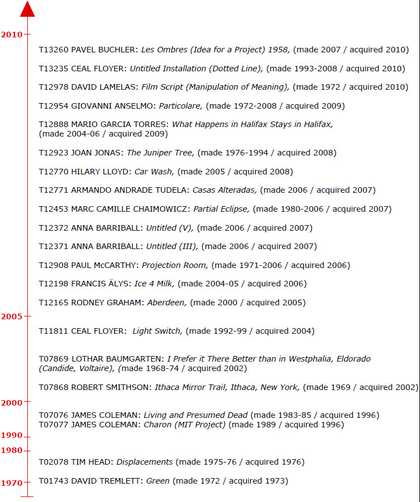It is rare that unique in-camera originals are included in the materials that arrive as part of the acquisition of a slide-based artwork into a fine art museum collection, as these works are usually sold as editions and the artist will typically retain the master slides. A common scenario is that a museum will obtain a number of sets of slides that are first-generation duplicates from the in-camera original, with an additional clause in the artist’s certificate that future copies should be requested from the artist. There is often an assumption that the museum will use the duplicates provided for display.
The quality of the slides that a museum receives varies. An artist such as James Coleman employs an archivist and his slides are tightly managed and kept under controlled environmental conditions. All of his images have been shot on identical slide stock using the same camera. The slide duplicates that form part of the acquisition are produced as three identical sets made at the same time, using the same stock and the same duplicating machine.
Works by other artists may be produced in a more ad-hoc fashion and be created and stored under less strictly controlled conditions. It is not unknown for slides which form the artist’s master set to have been used for display and to have faded or suffered damage. Duplicates taken from these for subsequent exhibitions are produced by different labs on different stock and it is from these slides that a selection is often made and given to the museum as part of the acquisition.
These very different scenarios may be indicative of the failings of a commercial gallery to understand what is involved in managing these works or the different artistic context in which these artworks were created. In some cases slides may have been chosen by the artist as a precise aesthetic visual medium whereas in other cases they may have been used more as a tool for documentation: for example in the context of conceptual art practices. When slides have been used more as a tool for documentation than as a precise aesthetic medium it is perhaps more common that the production and management of both the original master slides and their duplication has been less precisely managed.
Artists’ interviews are a standard tool of contemporary conservation practice. These interviews are formal moments in an ongoing dialogue between the artist and the museum that often continues for many years. The first interview is commonly conducted between conservators and the artist when a work comes into the collection, followed by the second interview at the point when the work is requested for display. During these interviews it is essential that the demise of 35 mm technology is discussed so that it is possible for conservators to work with these artists to understand more clearly the significance of slide technology to their works and to plan for the future of the work.
Resources
Example display specification and slide projector maintenance
This example display specification for Armando Andrade Tudela’s Casas Alteradas shows the kind of information crucial for our record keeping and the way in which we translate the information that we receive by the artist on how the work should be shown. There is also documentation related to the maintenance of the slide projector used in the artwork and its operating manual.
- Download the display specification for Armando Andrade Tudela’s Casas Alteradas (PDF, 506 KB)
- Download the instructions for installing Armando Andrade Tudela’s Casas Alteradas (PDF, 1.2 MB)
- Download the maintenance instructions for the Kodak S-AV 2050 slide projector (PDF, 174 KB)
- Download the operating manual for the Kodak S-AV 2050 slide projector (PDF, 1.7 MB)


